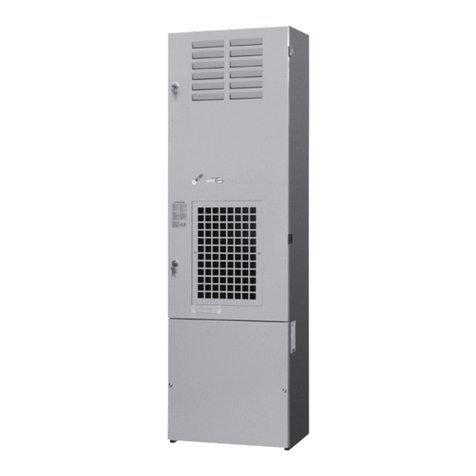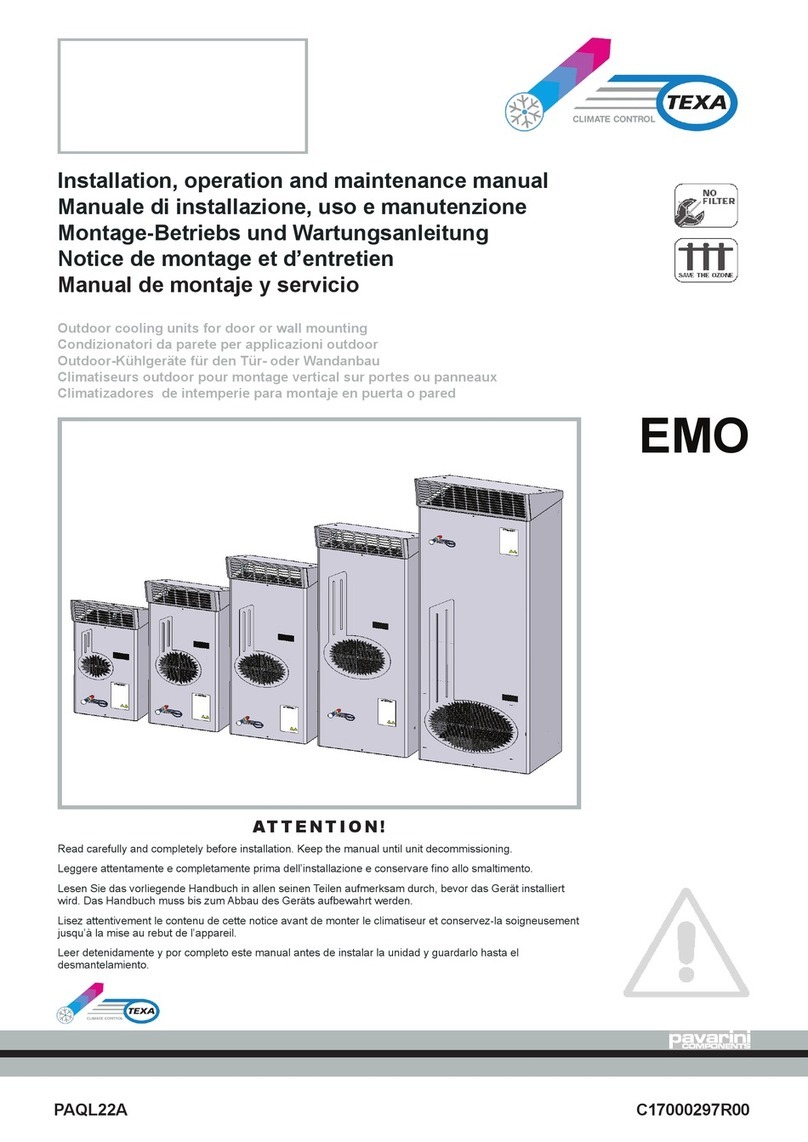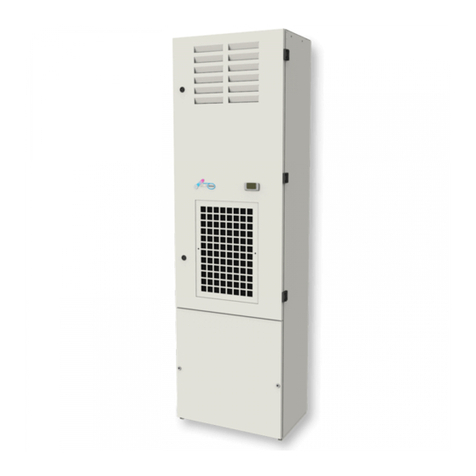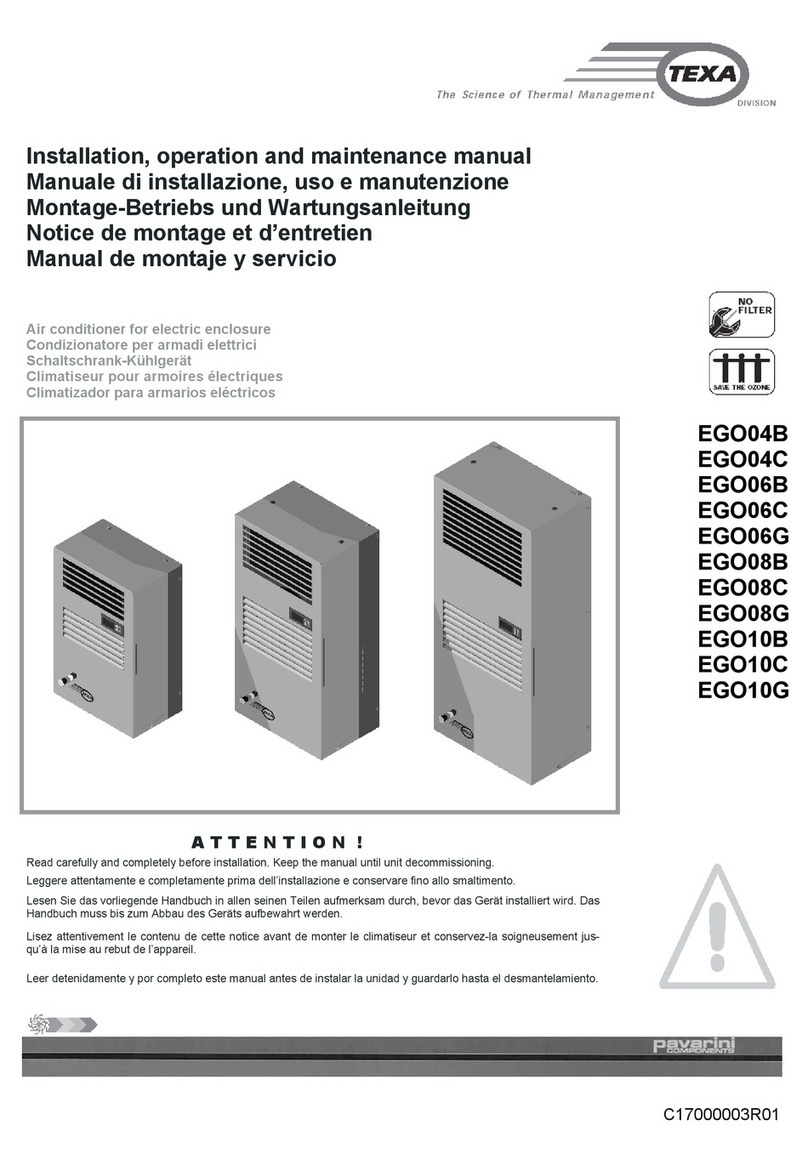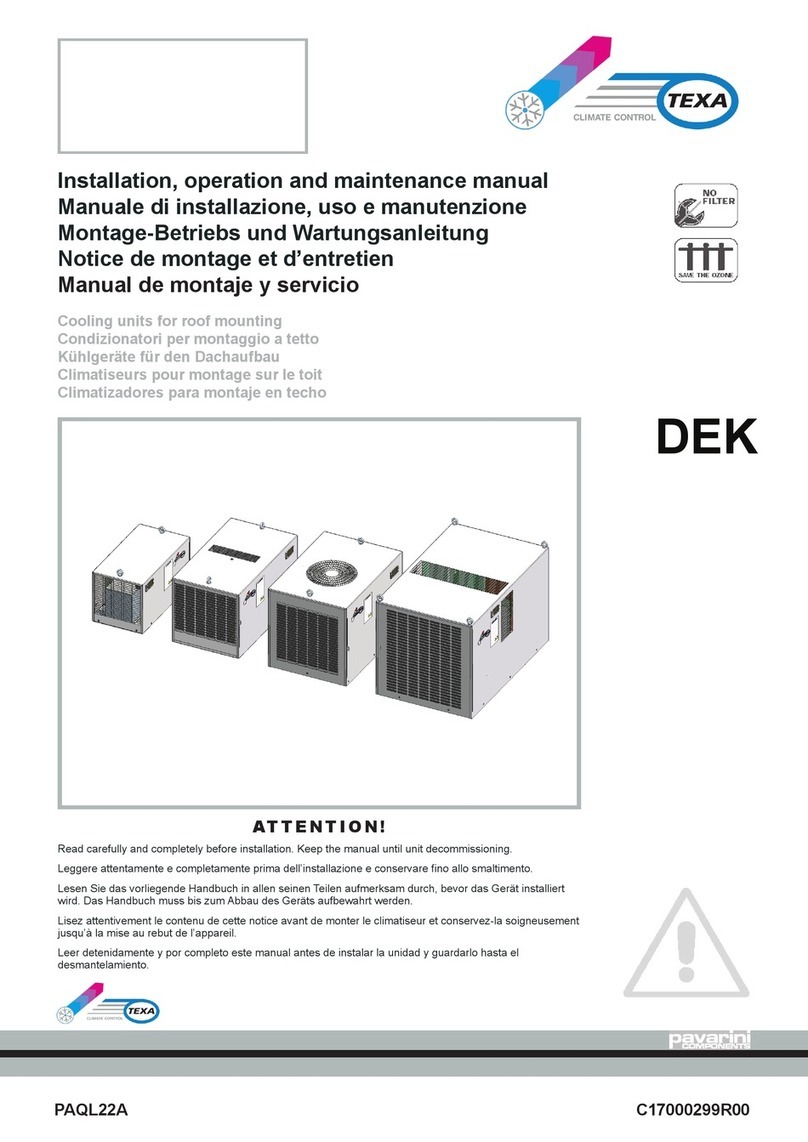
9
ENG
NOTICE
Immediately contact TEXA INDUSTRIES S.r.l.
in writing in the event of any damage or other
discrepancies.
5. Installation
WARNING
Disconnect power before starting any work
inside the switchboard.
WARNING
Installation of the machine must be performed
only by authorised and qualied personnel
using appropriate PPE.
CAUTION
Debur holes and slots to prevent cuts, above
all during the installation phase.
(gure F.13). These models nevertheless have
an emergency condensate outlet which can be
carried outside as described above. If the cooling
unit is used with the doors of the enclosure open,
excessive quantities of condensate will form and
this is an unauthorised condition of use (gure
F.09). We suggest using a position switch on the
door connected to the cooling unit’s digital input
to stop the unit if the door is opened. (See section
7.3)
7. Electrical Connection
WARNING
The electrical connection and any work on the
system or on electrical components must be
performed solely by specialised and authorised
personnel in compliance with electrical code
and any other applicable regulations.
WARNING
Isolate the power to the enclosure during the
connection phase.
WARNING
Ensure the machine is correctly earthed.
CAUTION
Make sure the supply voltage is compatible
with the voltage on the cooling unit’s rating
plate.
CAUTION
The power supply must be protected upline
of the machine using appropriate time-delay
fuses (type T) or circuit breakers with K-curve,
per the indications given in table F.13.
Connect the supply cable in accordance with
gure F.14.
7.1 Two-Phase Models
The two-phase models can operate with two
dierent supply voltages: 460V 2~50-60Hz and
400V 2~50-60Hz. If the available power supply
is 460V 2~50-60Hz, connect terminals L1(0) and
L3(460) on the terminal board (gure F.14). If,
on the other hand, the available supply voltage
is 400V 2~50-60Hz, connect terminals L1(0) and
L2(400) on the same terminal board.
The UL-listed models are tted with fuses on
the 460V 2~50-60Hz supply line located in the
corresponding fuse holders in the rear part of the
cooling unit (gure F.16).
7.2 Three-phase models
The three-phase UL-listed models with 460V 3~
60 Hz power supply can also be powered with
400V 3~ 50 Hz voltage by opening the rear panel
and modifying the connection of the cables on
the quick-release connector (gure F.19). On the
contrary, the models with only CE marking are
factory set for 400V 3~ 50 Hz and can be powered
with 460V 3~ 60 Hz voltage by modifying the
connection with the same procedure described
previously.
The UL-listed models are tted with fuses on
the 460V 3~ 60Hz supply line located in the
corresponding fuse holders in the rear part of the
cooling unit (gure F.16).
7.3 Alarm Pins
(gure F.15)
The input/output signals from the electronic control
unit are managed via the alarm pins:
- Alarm signals from the electronic control unit can
be taken from positions 1-2-3; in the event of an
alarm, the digital output relay will change state
- A digital input for voltage free contacts is available
on terminals 4-5
The cooling unit’s electronic control unit is
programmed to generate an alarm when the
digital input is open. When the digital input is not
being used, it is therefore necessary to bridge it
by connecting terminals 4 and 5 together with a
cable.
7.4 Sequencing (optional)
(gure F.17)
It is possible to connect two cooling units together
in sequence via the red 4-pole connector on the
rear of the machine; the cable is not supplied as
standard.
See the control unit manual to set the necessary
parameters.
7.5 Modbus (optional)
(gure F.18)
It is possible to make a modbus connection via the
4-pole connector on the rear of the machine; the
cable is not supplied as standard.
See the control unit manual to set the necessary
parameters.
8. First Start-Up and Regulation
CAUTION
If, prior to installation, the cooling unit was left
in an incorrect position (gure F.01), wait at
least 8 hours before switching it on.
Otherwise, 30 minutes is more than enough
time for the oil to return to the compressor,
after which the cooling unit can be powered
up.
Once voltage is applied, the enclosure air
intake fan will operate intermittently, making the
temperature inside the enclosure even. If this
temperature exceeds 2K above the set point, both
the compressor and external air fan will turn on,
causing the cooling cycle to start. This then stops
when the inside temperature reaches the set point.
The thermostat is factory-set to 35°C. The setpoint
can be set between 20°C and 45°C.
NOTICE
To save energy and minimise the production
of condensate, we recommend not setting the
setpoint below 30 °C.
Install the cooling unit with the enclosure air intake
hole in the highest possible point.
Ensure the xing elements and couplings will not
foul the equipment inside the enclosure itself.
If the cooling unit is to be installed on the door of
an electrical switchboard, make sure the door can
take the weight.
The
unit
must
be
installed
in
a
vertical
position.
Maximum permitted deviation from the vertical is
2°.
5.1 Installation of External Installation Versions
The cooling unit must be installed on the outside
of
the
electrical
switchboard.
Drill
the
holes
and
make the necessary cuts in the enclosure (gure
F.04) using the drilling template supplied with the
unit. Fit the sealing strip on the cooling unit on the
side
connected
to
the
enclosure
and
follow
the
assembly diagram (gure
F.04).
5.2
Installation
of
Semi-Recessed
Installation
Versions
Thanks
to
its
modular
conguration,
depending
on requirements the cooling unit can be installed
on the exterior of the electrical switchboard (gure
F.05)
or
semi-recessed
(gure
F.06)
without
the
need
for
further
accessories.
Depending
on
the
installation
option,
drill
the
holes
and
make
the
necessary cuts in the switchboard using the drilling
template supplied with the unit. Fit the sealing strip
on the cooling unit on the side connected to the
enclosure.
Follow
the
installation
diagram
given,
depending on the required installation type.
6. Condensate runo pipe
The condensate which, depending on the ambient
temperature and humidity conditions, forms on the
cooling unit which cools the enclosure air, is not
a
malfunction
but
a
normal
phenomenon
of
the
cooling unit. In models
NOX04-NOX06-NOX08,
this
condensate is taken outside through a hose at the
bottom of the cooling unit. It is possible to screw
on the hose barb supplied with the machine (gure
F.10) on which an 8 mm ID hose can be tted to
carry the condensate to another position, so that
the
discharge
can
be
made
at
a
point
where
it
does not represent a slipping hazard to personnel.
In
this
case,
make
sure
the
condensate
ows
without
any
hindrance.
Avoid
horizontal
lengths
of more than 0.5 metres, uphill sections and the
accidental formation of traps (gure
F.07). The end
of the condensate runo pipe must always be free
and never underwater. The end of the condensate
runo pipe must therefore not be placed inside a
condensate collection container (gure
F.08).
Models
NOX10
to
NOX60
are
tted
with
a condensate
evaporation
device
which
operates via
the
hot
(outlet)
tube
of
the
compressor
8.1 Electronic Thermostat
The NOX04 model is tted with a TX050
electronic thermostat.
See
the
specic
manual
C17000199 for
the
functions
of
this
thermostat
and
how
to program it.
8.2 Electronic Board
All other models in the NOX range are
equipped with an electronic board TX-i40 and a
display on which the operator can modify the
machine parameters. See the specic manual
TX-I40 MANUAL for the functions of this
thermostat and how to program it.
TEXA INDUSTRIES S.r.l. nor B&R Enclousres
(it's distributor in Australia)
shall be in no way
held
liable for any alterations the customer may
make
to the default parameters if they have not
received
authorisation to do so.
NOTICE












